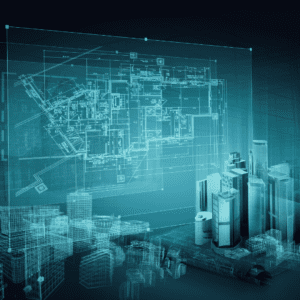新しい建物の改修や建設に伴う煩雑な手続きや官僚的プロセスは、大きなストレスの原因となることがあります。しかし、もし私たちが全体のデザインプロセスを効率化できたらどうでしょうか?この記事では、AIがどのように建築を革命的に変え、デザインをより迅速で効率的、かつ環境に優しいものにしているかを探ります。
建物は単なる構造物ではなく、私たちがこの地球にどのように住むかに不可欠な存在です。建築家は私たちの生活空間をデザインする上で重要な役割を果たし、それが創造的で機能的、持続可能で回復力のあるものであることを保証します。しかし、従来のデザインプロセスは時間がかかり、しばしば障害に悩まされます。

AIが建築デザインを変革する方法
単一の構造物を設計するには、環境規制を満たし、自然災害への耐性を確保するために必要な追加の時間を除いて、6ヶ月から18ヶ月かかることがあります。この長いプロセスは、効率的な建設にとって重要な障害です。
AIは、建築デザインにかかる時間と労力を削減する可能性を持っています。AIが単に静的画像レンダリングを生成するという現在の認識とは異なり、高度なAIは幾何学的システムを理解し、変更可能で編集可能な3Dモデルを生成することができます。この能力は、専門家にとって建設プロセスでの大きなアドバンテージとなります。
テキストから3Dモデルへ:実践的な例
二つの役員室を持つオフィスの設計図を作成する建築家チームを想像してみてください。彼らのプロセスは、テキストから3Dモデルへと直接進みます。基礎が整った今、彼らの中にはオープンスペースに向かって内向きの窓を望む役員に出会ったことがないことが明らかです。
ここでAIが登場し、その側面を取り除くために窓をシームレスに変更します。進展は明らかです。デザインレイアウトは有望ですが、まだ欠けている要素があります。AIは、材料の選択において建築家を導き、賢い選択がなされることを保証できます。しかし、本物の材料を選ぶには慎重な考慮が必要です。建築家は、材料自体だけでなく、その環境的および財政的影響も考慮しなければなりません。
AIを活用することで、彼らは自動的に炭素排出量を計算し、デザインがネットゼロに準拠していることを保証できます。これは、140以上の国がそのような基準を義務付けているため、ますます重要です。
また、AIは自然光の使用と家具の配置を最適化し、空間の機能性と快適性を向上させることができます。これらの賢い選択は、より効率的で快適な生活および作業環境につながります。
緊急時におけるAI
壊滅的な地震のような災害時には、迅速な建設の必要性が重要です。AIは、設計および建設プロセスを大幅に迅速化し、従来の時間の一部で緊急に必要な構造物を提供できます。さらに、AIは将来の災害を予測し、防ぐ手助けをすることができます。
AIは建築分野に革命をもたらす準備が整っています。デザインプロセスの加速から、スマートマテリアルの選択、災害準備の強化まで、AIは多くの利点を提供します。私たちがAIを建築実践に統合し続ける中で、より迅速で効率的、かつ持続可能な建築ソリューションが期待できます。
自分の分野で最新の情報を保つためには、AI技術を受け入れることが不可欠です。 NextBrain AI さまざまなドメインからのデータから貴重な戦略的洞察を提供します。 デモを今日予約してください その力を直接体験するために。


 +34 910 054 348
+34 910 054 348 +44 (0) 7903 493 317
+44 (0) 7903 493 317